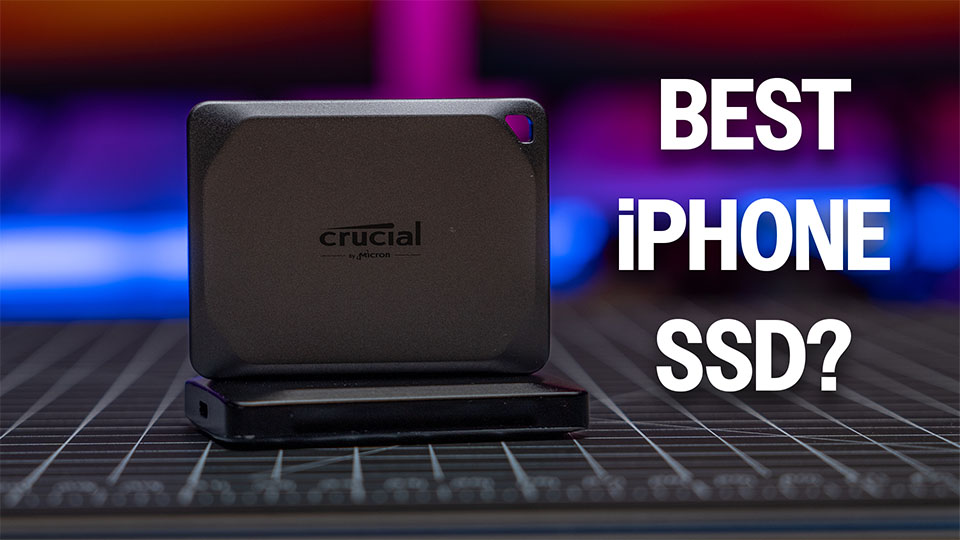Links in this post may be affiliate links. Any products purchased through affiliate links may provide a small commission which helps to support the SemiPro Tech+Gear site and YouTube channel.
With the new USB-C connectivity of the iPhone 15 Pro and Pro Max enabling external video recording, many owners are now wondering which external storage solution is the best choice for filming and general use. Are the Crucial X9 and X10 Pro a good option?
These tiny SSDs from Crucial certainly fit the bill when it comes to portability. They’re very small and lightweight, and offer water resistance, drop and dust protection. They also both offer write speeds that support the external recording from the iPhone 15 Pro and Pro Max, up to 4K 60fps. However, for Mac users there are some important details to be aware of.
Crucial X9 Pro
MSRP: $89 – $259 (1/2/4 TB)
Pros
- Terrific portability
- 1,000 MB/s speeds on Mac/Win
- Good price/GB ratio
Cons
- No Mac support for firmware updates
- May not be fast enough to edit video directly from it, depending on the size of your files
Best For: All-around portable storage including with your iPhone 15 Pro, but ONLY if you’re ok without Mac support for firmware updates.
Crucial X10 Pro
MSRP: $119 – $289 (1/2/4 TB)
Pros
- Super fast speeds IF you have a device with a USB 3.2 Gen 2×2 port (no modern Macs)
- Terrific portability
- Good price/GB ratio
Cons
- Apple silicon Macs do not have ports that will reach the maximum speeds (will be limited to 1,000MB/s)
- No Mac support for firmware updates
Best For: Users who have devices with a USB 3.2 Gen 2×2 port (none of the newer-generation Macs).
Specifications
| Capacities | Max Read | MaxWrite | USB Type | |
| X9 Pro | 1/2/4 TB | 1,050MB/s | 1,050MB/s | 3.2 Gen 2 |
| X10 Pro | 1/2/4 TB | 2,100MB/s | 2,000MB/s | 3.2 Gen 2×2 |
Dimensions are the same for both the X9 Pro and X10 Pro: 65 x 50mm with a weight of 1.4oz.
Compatibility: Windows, Mac, Android, iPad, PC, Linux, PlayStation and Xbox gaming consoles
Dust & Water Rating: IP55
Drop Rating: 2m / 7.5ft
Performance
The performance of any drive is going to be limited by two factors: the speeds supported by the port on your device, and the speed supported by the cable that you use to connect them. The iPhone 15 Pro has a maximum bandwidth of 10Gbps (USB 3.2 Gen 2), and with a cable that supports the same (included with the X9 Pro and X10 Pro), both drives are capable of taking full advantage of the iPhone’s speeds and then some. The X10 Pro does not see an advantage when it comes to iPhone use, because the USB port on the iPhone 15 Pro is not a Gen 2 2×2 port, so both drives will max out at speeds around 1,000MB/s or slightly less.
In practical terms, I’ve had no trouble recording longer content in 4K 24fps up to 30 minutes as well as 4K 60fps for shorter periods with both drives, in the ProRes HQ codec with Apple Log color profile. File transfers to my Macbook Pro have been consistently fast for both drives as well.
But form a more technical standpoint, we need to talk about the USB 3.2 Gen 2×2 connection of the X10 Pro. If you have a device with a compatible port, you can reach read & write speeds upwards of 2,000MB/s with the X10 Pro. However if you have any other type of port, even Thunderbolt ports that support faster speeds like Thunderbolt 4 (40Gbps), you will not get the maximum speeds of the X10 Pro. You will instead be limited to about half the max speed if your device doesn’t support Gen 2 2×2. More on this in a moment.
I tested the read and write speeds of the X9 Pro and X10 Pro on my Macbook Pro M1 (2021) using the Blackmagic Disk Speed Test app. Testing for the X9 Pro came back with average read speeds of 925MB/s and write speeds of 922MB/s. Meanwhile the X10 Pro returned average read speeds of 927MB/s and write speeds of 924MB/s. How can they be nearly identical? See my earlier statement about devices with ports that don’t support USB 3.2 Gen 2×2. This will hold true regardless of the type of cable that is used.
What is USB 3.2 Gen 2×2?
The naming conventions of USB standards is confusing. Regular USB 3.2 Gen 2 supports a maximum bandwidth of 10Gbps. The latest USB technology, USB 4, has a maximum bandwidth of 40Gbps. Thunderbolt is different than USB, however Thunderbolt 3 and 4 both use a USB-C connector.
USB 3.2 Gen 2×2 is an advancement of USB 3.2 Gen 2 that uses “dual-lane” capabilities to effectively double the bandwidth to a maximum of 20Gbps. This is not the latest & greatest USB technology – as I mentioned, USB 4 is the most recent advancement. However USB 3.2 Gen 2×2 is easier and less expensive for manufacturers to obtain currently, so several storage devices released in the last 2 years that use marketing terms like “super fast” and “extreme” when referring to their speeds are USB 3.2 Gen 2×2, including SanDisk Extreme Pro SSDs, Samsung’s latest T9 SSDs, and the Crucial X10 Pro. As a side note, I would not recommend the Sandisk Extreme Pro models, as several users (including staff at Ars Technica and The Verge) have reported losing data. I bought one myself before learning about this issue but have since moved all my data off of it (it was one of the impacted 4TB models).
Mac Limitations
So why all the talk about USB 3.2 Gen 2×2? As seen in my performance tests, Mac users are most likely not going to get the maximum speeds from the X10 Pro. In the last several years, Apple has trended towards Thunderbolt 3 and 4 ports on new devices. None of the current generation of Macs have a 3.2 2×2 compatible port, so the X10 Pro will be limited to about half the maximum speed. Apple is likely going to continue moving forward with USB4 and Thunderbolt 4 since USB 3.2 Gen 2×2 is no longer a “new” technology.
There’s one more limitation for Mac users specific to Crucial external drives. Crucial does not, at the time of this writing, offer software for MacOS to update the firmware on their drives. Crucial does have a Windows firmware updater, but no option for Mac. This means that if Crucial does provide a firmware update at some point, Mac users would need to get access to a Windows device just to install the update. External drives don’t frequently need firmware updates, but on the off-chance a bug or usability issue is discovered at some point, a firmware update could be necessary. So at this time if you’re looking at a Crucial external drive and only have Mac devices, be aware you won’t be able to update the firmware easily.
Conclusion
Ultimately, I do really like these drives. Right now there aren’t many options on the market with this form factor and speeds. Samsung T7 drives match the speeds of the X9 Pro and are comparable in price (and can receive firmware updates on Macs), but are slightly larger in size.
In terms of portability, they are a great option to pair with the new iPhone 15 Pro/Max for external video recording. The X9 Pro would be my recommendation for Mac device owners because you’ll get nearly identical speeds with the X10 Pro, but for a lower price. For Windows users, especially those with devices that support USB 3.2 Gen 2×2, the X10 Pro is a great option as well because you’ll get excellent speeds, fast enough to edit large video files like ProRes directly off the drive.


